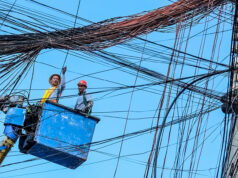PHL growth forecast upgraded despite risks

By Tobias Jared Tomas
and Abigail Marie P. Yraola, Researcher
THE PHILIPPINE economy is expected to grow above 6% this year, according to revised estimates by the ASEAN+3 Macroeconomic Research Office (AMRO) and United Nations Economic and Social Commission for Asia and the Pacific (UN ESCAP) released on Tuesday.
However, the upgraded growth projections are still below the government’s 7-9% target this year.
In its latest regional economic outlook report, AMRO said the Philippines’ gross domestic product (GDP) is projected to expand by 6.5% this year, slightly higher than the 6.2% estimate given in January.
The UN ESCAP, on the other hand, said Philippine GDP is expected to grow by 6.3% this year, a tad better than the previous estimate of 6%.
The economy expanded by 5.7% in 2021.
For 2023, AMRO’s growth forecast for the Philippines is 6.5%, within the government’s 6-7% goal.
“This year, we expect growth to be improved to 6.5%, and this will be led by government spending and also the recovery in the private sector’s spending,” AMRO Chief Economist Hoe Ee Khor said at a virtual briefing. “We expect that private spending will bounce back very rapidly once the economy reopens much more fully.”
However, AMRO said the biggest threat to the Philippines’ recovery is a possible resurgence in coronavirus infections. Health experts have recently warned of a surge in cases after the May elections, citing the “waning immunity” of many vaccinated Filipinos who have not received a booster shot.
AMRO also cited companies’ solvency as a risk to the banking sector, as well as heightened capital flow volatility due to global policy tightening.
Despite this, the Philippines’ growth rate is expected to be higher than the Association of Southeast Asian Nations (ASEAN) average of 5.1% this year and 5.2% in 2023. In ASEAN, the Philippines is likely to post the fastest GDP growth this year together with Vietnam, and the second-highest growth in 2023.
The region’s growth outlook is supported by high vaccination rates, which allowed many countries to stay open despite the Omicron surge.
“Our assessment therefore is that unless a more virulent variant of COVID emerges, which is resistant to the vaccines, economies are expected to remain quite open and will recover quite strongly this year,” Mr. Khor said.
AMRO said the Russia-Ukraine war is a risk to the growth outlook, along with the recurrence of global supply chain disruptions due to COVID-19 and a sharper-than-expected monetary policy normalization in the United States.
“The ongoing Russia-Ukraine conflict is expected to have a limited impact on the region’s GDP growth in 2022 given regional economies’ small exposure to the two economies engaged in the conflict. An escalation and prolongation of the conflict would, however, pose a downside risk to growth,” it added.
AMRO said Philippine inflation is expected to accelerate to 4.1% in 2022 from 3.9% in 2021. This is lower than the Bangko Sentral ng Pilipinas (BSP) inflation projection of 4.3%, but above the 2-4% target. Inflation is expected to ease to 3.5% by 2023.
Mr. Khor said it is unlikely for the central bank to tighten policy rates soon, citing a negative output gap and modest consumer demand. “We do not see an urgent need to raise the policy rate.”
Mr. Khor also said the central bank should begin withdrawing some of it’s policy stimulus, “as the economy continues to gain traction and growth continues to recover.”
HIGHER GROWTH
Meanwhile, the UN ESCAP’s upgraded 6.3% growth projection for the Philippines this year is the second highest in Southeast Asia, after Vietnam’s 6.5%.
In its report entitled Economic and Social Survey of Asia and the Pacific 2022: Building Forward Fairer, UNESCAP also projected a 6.7% GDP growth for the Philippines in 2023.
The revised projections are above the UN ESCAP’s regional growth forecast of 5% this year and 5.2% in 2023.
“The slight upward revision for the Philippines is based on an assessment that domestic demand will strengthen with easing restrictions and reopening of borders, which will benefit the service sector,” UN ESCAP Director of Macroeconomic Policy and Financing for Development Division Hamza Ali Malik said in an e-mail.
“While trying to understand changes in GDP forecasts for 2022 and 2023, it is important to understand and acknowledge the sheer scale of uncertainty faced by economies,” Mr. Malik said.
He noted that the Philippines has not completely recovered from the pandemic when the Russia-Ukraine war began in late February.
The economy may benefit from the reopening of borders around the world, allowing more Filipinos to work abroad and send more money that will support domestic consumption, Mr. Malik said.
Fiscal expenditures, on the other hand, are expected to continue to support growth through large infrastructure projects.
Meanwhile, UN ESCAP said Philippine inflation is projected to average 3.3% this year from 4.5% in 2021. For 2023, inflation is estimated to average 3%.
“Inflation has been modest in the first few months of 2022 but the recent surge in global oil and commodity prices due to the Russia-Ukraine conflict is likely to add to price pressures. As long as inflation remains within the central bank target range, monetary policy can remain accommodative to support recovery,” Mr. Malik said.
Risks to the growth outlook for the Philippines include new coronavirus variants, renewed lockdowns and slower export growth due to the ongoing Ukraine war, he added.




